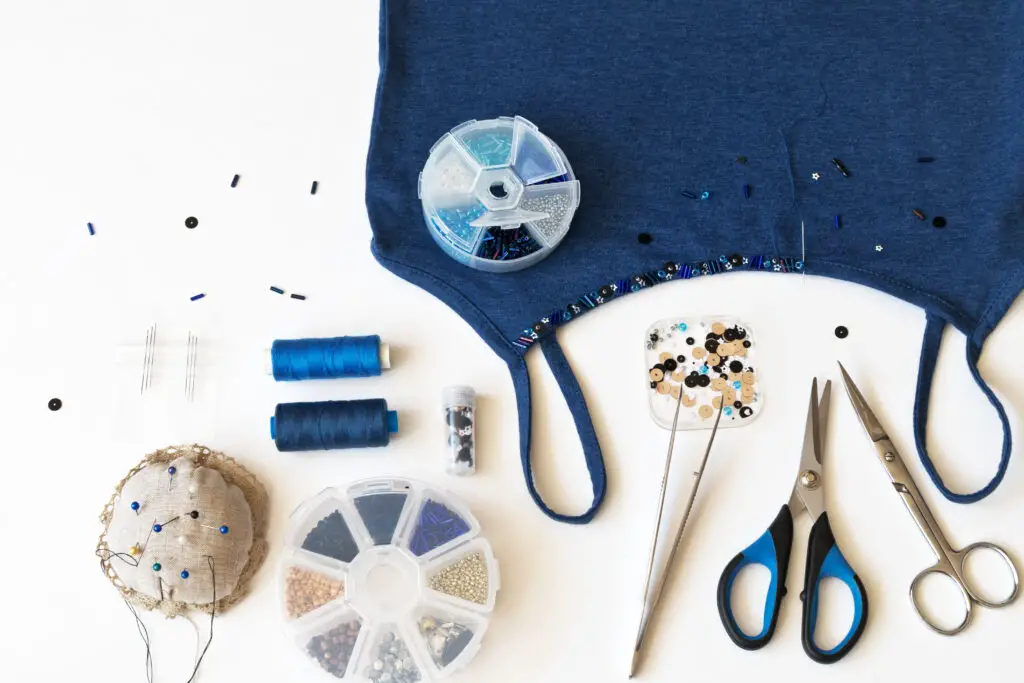
If you’ve paid any attention to fashion over the past few years, you’ll have noticed beadwork making a big comeback. It’s used to decorate tops, dresses and jackets, to create pretty ornamental bags and to add a glamorous touch to home furnishings. So what do you need to know to have a go at it yourself?
Types of beads
There are lots of places to find beautiful beads. Try visiting craft shops as well as your usual sewing supply shop, and check out the internet sites that sell them – since they’re very cheap to post, mail order can be a practical option. If you want a lot of similar beads, it can be a good idea to buy in bulk, as this often reduces the price dramatically.
When choosing beads, think about the practicalities of how they’re going to be used. Large beads on clothes or bags can easily get caught on things and pulled off. Beads on cushions are more comfortable to lean against if they’re smooth and flat. Beads on curtains or wall hangings often need to be larger to be noticed.
Beads are made from many different materials – bone, metal, wood, plastic, shell, ceramics and even raw gemstones (which can be surprisingly cheap). Strangely enough, not all beads come pre-pierced, so check before you buy. A bodkin is a useful tool for pressing through obscured or incomplete bead holes, but you should always buy a few more beads than you need in case of problems. They’re also very easy to lose!
Bead patterns
Most of the time when you’re using beads you’ll want to create a pattern, similar to embroidery. You can buy beadwork patterns or find them for free via the internet or your local library. It’s also pretty easy to copy or adapt existing designs. Many people, however, find that much of the fun comes from making their own.
The best way to develop a bead pattern is to sketch it out on paper first. Measure it against your fabric to work out roughly how many beads you’ll need. Once you have your beads, use a sheet of sticky paper to lay them out in the shape you want and draw the pattern in chalk on your fabric. This way you can match the two at each stage and easily keep track of what you’re doing.
There are many different ways to approach bead patterns. Sometimes simple rows of identical beads can look stunning. On other occasions beads work best as a delicate trimming. When you’re making clothes or furnishings for children, bead pictures can be popular. Bear in mind, though, that small children can pull beads off and eat them – it’s best not to use them for under-threes.
Sewing beads
In most instances, you can sew beads directly onto the fabric you want to decorate. However, if you are decorating fabric with a significant pile, such as velvet, it may be better to sew the beads onto a patch or ribbon of smoother fabric and then stitch that in place.
There are two ways to stitch beads – singly, or in rows. The former provides the most security, meaning that only one bead is likely to pull loose at a time, but it can be extremely time consuming and it’s not recommended if you have a large area to cover with beads.
If you are sewing beads singly, use backstitching to hold them in place. When sewing them in rows, you should use the technique known as couching. This involves attaching a row of beads to the fabric with one long stitch, then using a different needle and thread to stitch diagonally across the way so that the thread between each bead is pinned down.
Couching is a quick way to set beads in place and it can work very effectively. You can even perform the second stage of it using a sewing machine.
Remember that when you are sewing beads you will need a smooth, strong thread (nylon is often best) and a small, fine needle. You may also find a thimble helpful. Beadwork can be hard on your hands but the results are very rewarding. It’s a great way to create beautiful, unique items that really show off your dedication and ingenuity.
